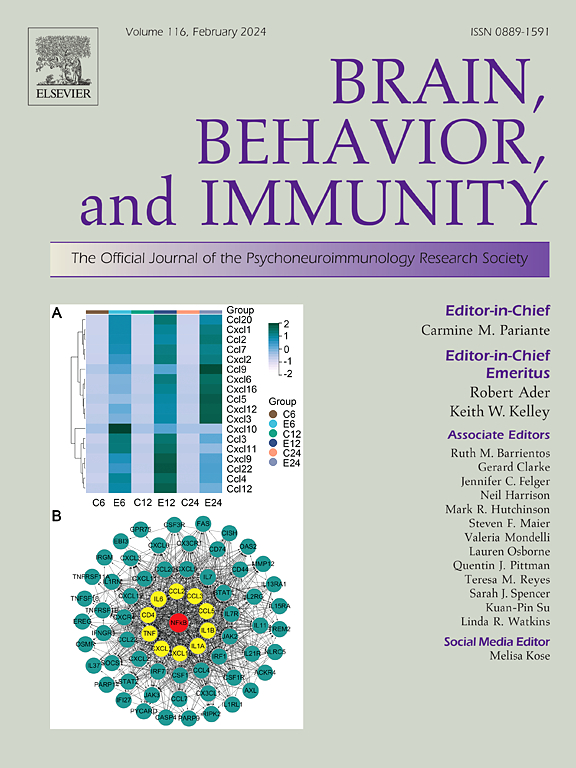Early life adversity promotes a milieu in favor of catabolic bone turnover in females: Mycobacterium vaccae NCTC 11659 proofs protective in preclinical studies
IF 7.6
2区 医学
Q1 IMMUNOLOGY
引用次数: 0
Abstract
Despite early clinical studies supporting the hypothesis that early life adversity (ELA) negatively affects the bone and despite typical ELA-associated disorders, including post-traumatic stress disorder (PTSD) and major depressive disorder (MD), are associated with osteoporosis and increased bone fracture risk, preclinical studies do not support this association. However, previous studies were only conducted in male but not female mice. In the current study we showed that ELA, induced by the classical maternal separation (MS) paradigm, facilitated femoral osteoclast activity specifically in female but not male mice. This was associated with a transient decline in both intestinal alpha diversity and Firmicutes/Bacteroidetes ratio, suggesting that the microbiome-gut-bone axis is involved in these effects. Moreover, ELA long-lastingly increased the femoral mRNA expression of the proinflammatory cytokine interleukin-6 (IL-6) and the osteoclastic markers Cathepsin K and RANKL. Importantly, all sex-specific ELA effects on bone were absent in female mice administered with M. vaccae NCTC (National Collection of Type Cultures) 11659 following ELA exposure. Finally, our clinical data indicate strong associations between ELA and development of an osteopenic/osteoporotic bone phenotype in postmenopausal women undergoing bone diagnostics. Together, our preclinical and clinical findings indicate that i) ELA negatively affects the bone, ii) these effects are specific for female sex, iii) the negative effects of ELA on female bone are associated with transient changes in the composition of the intestinal microbiome followed by long-lasting activation of the immune system and the HPA axis, together setting the stage for a facilitated catabolic bone turnover and development of an osteopenic/osteoporotic bone phenotype, iv) developing immunoregulatory approaches, such as repeated s.c. administrations with immunoregulatory microorganisms, have potential for prevention/treatment of ELA-related bone disorders.
早期生活逆境促进了有利于女性分解代谢骨转换的环境:母牛分枝杆菌nct11659在临床前研究中证明具有保护作用。
尽管早期临床研究支持早期生活逆境(ELA)对骨骼有负面影响的假设,尽管典型的ELA相关疾病,包括创伤后应激障碍(PTSD)和重度抑郁症(MD),与骨质疏松症和骨折风险增加有关,但临床前研究并不支持这种关联。然而,之前的研究只使用了雄性老鼠,而不是雌性老鼠。在目前的研究中,我们发现由经典母体分离(MS)模式诱导的ELA在雌性小鼠中特异性地促进了股骨破骨细胞的活性,而在雄性小鼠中没有。这与肠道α多样性和厚壁菌门/拟杆菌门比值的短暂下降有关,表明微生物群-肠-骨轴参与了这些影响。此外,ELA长期增加了促炎细胞因子白细胞介素-6 (IL-6)和破骨细胞标志物Cathepsin K和RANKL的mRNA表达。重要的是,在暴露于ELA后,母牛分枝杆菌NCTC 11659的雌性小鼠中,所有性别特异性的ELA对骨骼的影响都不存在。最后,我们的临床数据表明,在接受骨诊断的绝经后妇女中,ELA与骨质减少/骨质疏松性骨表型的发展有很强的相关性。总之,我们的临床前和临床研究结果表明,1)ELA对骨骼有负面影响,2)这些影响是女性特有的,3)ELA对女性骨骼的负面影响与肠道微生物组组成的短暂变化有关,随后是免疫系统和HPA轴的长期激活,共同为促进分解代谢骨转换和骨质减少/骨质疏松的发展奠定了基础。iv)开发免疫调节方法,例如用免疫调节微生物重复给药,具有预防/治疗ela相关骨疾病的潜力。
本文章由计算机程序翻译,如有差异,请以英文原文为准。
求助全文
约1分钟内获得全文
求助全文
来源期刊
CiteScore
29.60
自引率
2.00%
发文量
290
审稿时长
28 days
期刊介绍:
Established in 1987, Brain, Behavior, and Immunity proudly serves as the official journal of the Psychoneuroimmunology Research Society (PNIRS). This pioneering journal is dedicated to publishing peer-reviewed basic, experimental, and clinical studies that explore the intricate interactions among behavioral, neural, endocrine, and immune systems in both humans and animals.
As an international and interdisciplinary platform, Brain, Behavior, and Immunity focuses on original research spanning neuroscience, immunology, integrative physiology, behavioral biology, psychiatry, psychology, and clinical medicine. The journal is inclusive of research conducted at various levels, including molecular, cellular, social, and whole organism perspectives. With a commitment to efficiency, the journal facilitates online submission and review, ensuring timely publication of experimental results. Manuscripts typically undergo peer review and are returned to authors within 30 days of submission. It's worth noting that Brain, Behavior, and Immunity, published eight times a year, does not impose submission fees or page charges, fostering an open and accessible platform for scientific discourse.

 求助内容:
求助内容: 应助结果提醒方式:
应助结果提醒方式:


